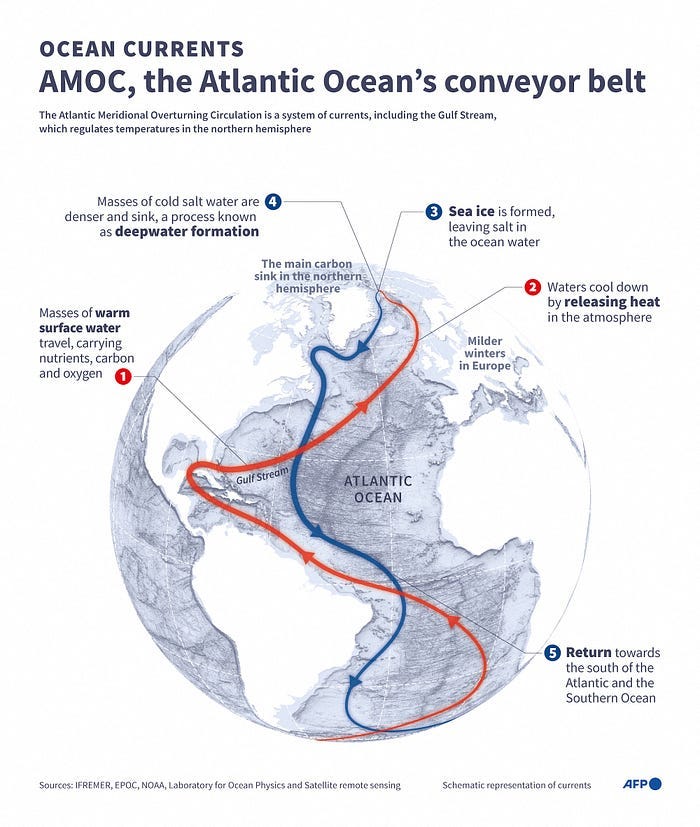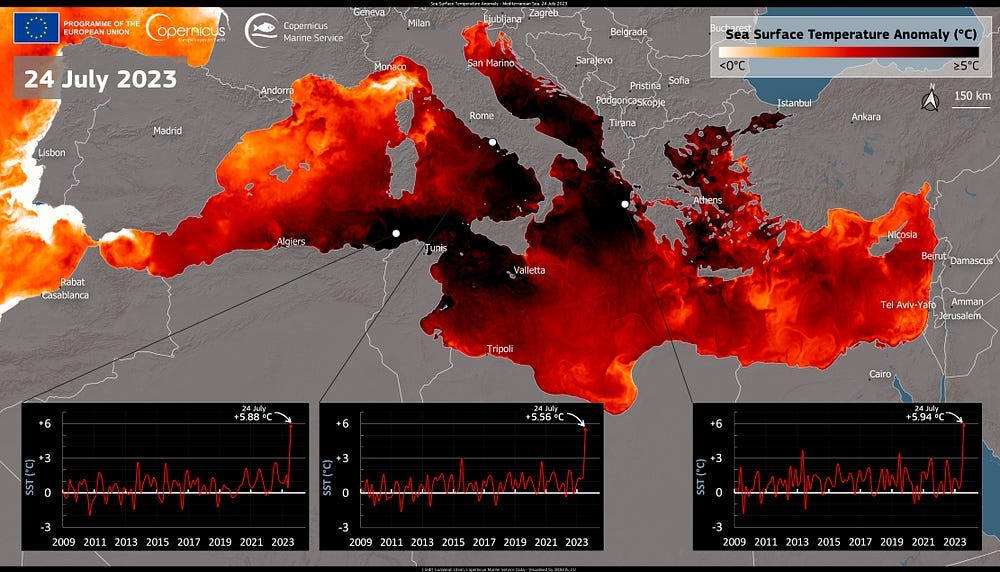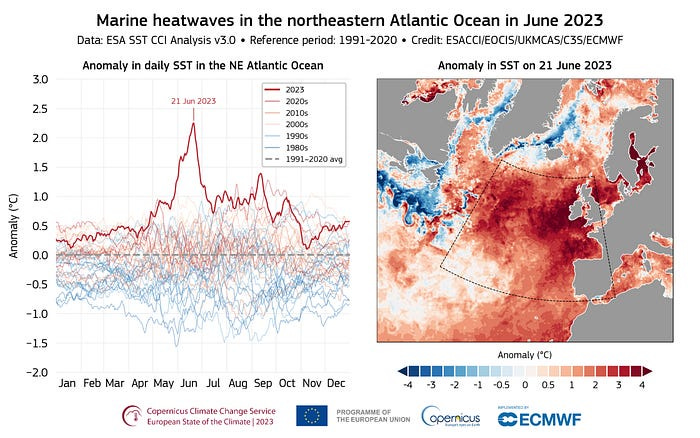How Long Before the Atlantic Ocean’s Collapse?
The world keeps acting like the timeline is unclear. The direction we’re headed isn’t.

I must’ve been twelve or thirteen. My grandfather’s woodstove was crackling in the corner, and a mug of hot cocoa was warming my hands. We had just unwrapped the shrink film from a brand-new DVD — The Day After Tomorrow. It was winter in Patagonia, and the frost clung to the windows like old secrets, which made the idea of instant glaciers feel somehow appropriate, even if I didn’t understand much of what was happening onscreen.
But I remember this: the Statue of Liberty frozen mid-scream. That image stuck. Not the science, not the dialogue. Just Lady Liberty, choked in silence, half-submerged in snow. I can almost feel my hands clutching the mug a little tighter. Not because I understood what thermohaline circulation was, but because I suddenly understood that weather could turn monstrous.
That movie planted something in my head — and in the heads of a whole generation of millennials. Most of us didn’t walk away knowing what the Atlantic Meridional Overturning Current (or AMOC for short) was. We remembered the feeling of the collapsing timeline where tomorrow became yesterday overnight: If this thing breaks, everything breaks.
Now, two decades later, that cinematic fear has found its real-world reflection. The AMOC — Earth’s colossal deep-ocean current system — is no Hollywood invention. It’s a planetary heartbeat. And it’s weakening faster than at any point in the last thousand years.
What helped me understand what’s going on with it wasn’t the special effects. It was that childhood cocoa right next to my grandfather.
Because, how do you cool down a burning cup of chocolate? You blow on it. Gusts of cold air meeting hot liquid. A transfer of energy. A kind of circulation.
Now imagine that cup is the Atlantic Ocean, and the gusts don’t show up.
That’s how you get the part they missed in the movies:
It’s not the freeze that hits first.
It’s the heat.
The AMOC: A Pulse Beneath the Surface
You can’t see it from the shore. But somewhere deep beneath the waves — beneath the yachts, the tankers, the dolphin-sighting cruises — the AMOC is shaping the boundaries of life on Earth, distributing warm and cold water between the poles through deep and near-surface currents.
During its northward journey, it carries warm, salty surface water from the tropics through the Caribbean Sea and Gulf of Mexico in a stretch known as the Gulf Stream (where waters can reach hot tub temperatures), then along the U.S. East Coast before crossing the Atlantic toward Greenland and Iceland. There, the warm waters meet frigid Arctic air, releasing their heat into the atmosphere like a global radiator. Cooled and densified, the water plunges into the abyss and crawls along the seabed all the way to Antarctica. It’s a planetary circulation loop — a conveyor belt that stabilizes the weather, feeds the Amazon’s rains, oxygenates the deep sea, and moves more energy than a million nuclear reactors.

But what happens when the pulse begins to fail?
Mounting evidence suggests it already is. The AMOC is now at its weakest point in a millennium, and scientists have repeatedly warned of its debilitating state.
Off the coast of Iceland, in a place called the Irminger Sea, there’s a stubborn patch of ocean that just… isn’t warming. In a world that’s breaking heat records year after year, this patch is cooling. A frigid bruise in an overheating body. Scientists call it the North Atlantic Warming Hole — or more bluntly, the Cold Blob.
When oceanic circulation is healthy, warm water flows north, heat is released into the atmosphere, and denser cold water sinks. But when a surge of fresh water from melting glaciers — especially from Greenland — floods the system, it dilutes the salt, lightens the water, and clogs the sinkhole. The result? Less sinking. Less circulation. More instability. Like dumping syrup into a drainage system and wondering why nothing moves. This anomaly is known as the AMOC fingerprint of a collapsing system.
This isn’t just a technical problem buried in charts. It’s an amplifying feedback loop: the weaker the AMOC gets, the warmer and saltier the South Atlantic becomes, and the harder it is to kickstart the cycle again. A planetary spiral — downward.
A very recent study just confirmed that the Cold Blob isn’t random noise. It’s a direct result of the AMOC weakening. Only climate models that simulate a weakened overturning circulation are able to replicate the observed cooling and freshening in that region.
Still, projections are, at the very least, chaotic. Some models point to a potential collapse within decades. Others suggest the slowdown could stretch over the century and into the next one. But whether we hit the wall at 20 km/h or 120, we’re still heading straight for it.
The timeline is up for debate. The direction is not.
Fast and Furious, Slow and Gradual
It’s tempting to cling to the slower version of collapse. To imagine we’ve got time. And in a way, we might, but it’s a hell of a gamble with real estate in denial.
Two recent studies in Nature Geoscience and Nature suggest the AMOC might not nosedive in the next few decades. Instead, the breakdown could unfold like a ceiling fan winding down — not with a bang, but with a long, breathless whir. Winds in the Southern Ocean still stir Arctic water back to the surface, just like me blowing gusts of cold air into the hot chocolate, delaying the inevitable. The models point to a slowdown of 18 to 43% by 2100. That’s your fan running at half speed — still moving, but no longer cooling the room.
This is obviously a pretty big range. And yet even a “moderate” weakening could reshape the climate’s architecture. The last time the AMOC slowed by 30% — for just two years in 2009–2010 — sea levels along the U.S. East Coast jumped five inches. To put this in perspective: the average yearly rise is only 0.17 inches, meaning this brief slowdown caused the equivalent of nearly 30 years of sea level rise.
Much of the confusion comes down to how different models frame the present. Some assume the AMOC is still robust and deep-reaching, pulling warm surface water into the abyss. Those show a steep drop-off ahead. Others depict a shallower, weakened current — one where surface heat and freshwater melt mostly linger near the top, never making it down. The North Atlantic today seems to be aligning with the latter.
The deeper problem is that we are forecasting the future of Earth’s circulatory system with barely two decades of direct measurements. Systematic monitoring of the AMOC only began in 2004. That’s like trying to predict a person’s lifetime heart health from a single EKG.
The models struggle. They’re biased. They contradict observed trends. And they still fail to capture key dynamics — especially feedbacks between melting ice and ocean currents. It’s entirely possible we’re being lulled by faulty optimism.
But there’s an underlying consistency: while these studies might suggest a longer runway, they also reveal an unnerving pattern: after 2100, most models crash. The longer-term trajectory isn’t ambiguous. It’s collapse.
There’s a lot of “mights,” “coulds,” and “woulds” — extrapolations piled atop educated guesses about all things that could happen when the current breakdown occurs. The most frightening predictions describe a world thrown into chaos, a “profound global-scale reorganization” of our climate. A long emergency — silent, compounding, irreversible.
Now, we have science and hard evidence to show as a glimpse of what could happen with a full AMOC collapse. And it was nothing like a sci-fi storm.
Simply put, you cannot adapt to this.

Case Study: An AMOC Anomaly Into a Global Heatwave
It was supposed to be a cold spot. The North Atlantic’s “cold blob” — that stubborn patch south of Greenland — had long been a fingerprint of the AMOC’s weakening. But during the June 2023 record-breaking marine heatwave, something snapped.
The blob didn’t just shrink. It flipped.
Temperatures soared 2°C above average — the biggest reversal in the region’s recorded history. The North Atlantic as a whole warmed 1.4°C above normal, nearly double the previous record set in 2010. The anomaly was so extreme, scientists didn’t have a category for it. “Off the charts” wasn’t a metaphor anymore — it was a data point.

The dominoes fell fast. Europe roasted under back-to-back heatwaves, flash floods tore through Eastern cities, Switzerland lost 4% of its glacier volume, and Mediterranean wildfires burned forests to ash. In the Caribbean, corals bleached like peeled bone under searing heat. Hurricanes spun faster and hit harder, powered by boiling seas.
What the hell happened? Was the AMOC coming back from the dead? Or was this the fever dream of a planet spinning out of control?
It was undeniable that the anomalous warm temperatures southeast of Greenland were part of the unprecedented marine heatwave that had developed across much of the North Atlantic Ocean.
But the truth was far stranger. The warmth wasn’t coming from below — the ocean’s natural mixing was actually trying to cool things down. The warmth was coming from above, from the interaction between air and sea (air-sea heat fluxes). So the key factor turned out to be the unusually calm surface winds.
To understand what happened, we need to go back to that fireplace and the warm mug in my hands and think of the North Atlantic Ocean as the content of that cup. Usually, when you blow (just like the wind), you stir and mix the content, creating a deep, cool layer at the top. The stronger you blow, the deeper the mixing penetrates, so strong winds create a thick upper layer and weak winds generate a shallower layer. In this case, the winds in the North Atlantic Ocean were unusually weak. Imagine spreading your hot cocoa into a shallow plate instead of keeping it in a mug. A shallow layer heats up much faster in the sun.

The winds were at their weakest measured levels during June and July, possibly linked to a developing El Niño in the eastern Pacific Ocean.
In some areas, the upper ocean layer — which is usually 20 to 40 meters deep — was just ten. That’s like switching from a pressure cooker to a frying pan. The ocean was wearing a tank top instead of a long-sleeve UV protection shirt, making it much more sensitive to the sun’s heat.
There was also the clearer skies left behind after new shipping regulations kicked in. In 2020, the IMO enacted a rule cutting sulfate emissions from ships to reduce air pollution. It worked. But it also thinned marine cloud layers that had been shielding parts of the ocean. Less pollution, fewer clouds, more sunlight — and suddenly the ocean was catching solar radiation like a tin roof in midsummer.
The AMOC didn’t cause the heatwave. But its fingerprint was all over the wreckage. This is what instability looks like — not as a sudden cinematic collapse, but as weird weather stacking on itself, cascading across the planet, reshaping what a “normal” year looks like. Because the same forces that brought us this freakish marine heatwave — calm winds, altered mixing, more sunlight — are all expected to become more common in a warming world.
The AMOC is changing in ways no one expected.
And dragging the entire planet with it.
This Isn’t About Collapse — It’s About Living Through the Unraveling
You don’t wake up all of a sudden the moment the AMOC collapses.
You wake up sweating through a heatwave in late winter. You cancel a family trip because the air is filled with smoke. You pay double for an espresso and triple for fish you used to catch when you where young. You stand in your kitchen watching stormwater pour through the cracks, again, and wonder what the insurance will cover this time.
That’s how this ends — not with a bang, but with everything else getting louder.
Marine heatwaves like the one in 2023 are the prototypes expected to worsen as our planet continues to warm due to greenhouse gas emissions. Ocean temperatures keep climbing, ecosystems are unraveling in real time, and Europe is being primed for another round of brutal land heat this summer, with water off the coast of the United Kingdom registering temperatures up to 4°C above normal.
The “cold blob” may have reappeared, but that’s not a sign of recovery. It’s a false calm before the next rupture.
The tipping points are already snapping around us. Just read the obituaries:
The coral reefs are turning bone-white. The Amazon is coughing through its worst drought on record. Antarctica and Greenland are leaking future sea level rise into the ocean like IV bags cracked open. Each of these tipping points is a striking reminder of what happens when the world keeps spinning business as usual.
So, how much time do we have before the Atlantic Ocean’s collapse?
No one knows for sure. This isn’t a light switch. It’s a complex, non-linear process full of feedbacks — rainfall patterns, ice melt, salinity flows — and the moment we cross the line, the climate will start writing a different story. One with a colder, stormier North, a drowned South, and equatorial zones too hot to inhabit. One where Europe might stand alone as the one region set to get much cooler in a warmer world.

Whether the current dies a slower or faster death won’t matter in the long run if the world breaches that threshold. And while we’ve gained some breathing room, this isn’t a time for complacency. It’s like getting a slightly longer deadline for a crucial project — it helps, but the fundamental problem still needs to be addressed. Now.
Will humans survive? Maybe. But survival isn’t the same as thriving.
What happens when one-in-10 winters in London see cold extremes approaching -20C, or winter extremes in Oslo in Norway plummet to around -48C? What happens to coastal cities when seas rise by meters? How many generations will it take before the AMOC even begins to recover, assuming it ever can in a world where CO₂ levels are higher than they’ve been in millions of years? The last collapse lasted about 1,000 years.
This is the outcome of two undeniable forces: burning fossil fuels and stripping the Earth of its forests. Stopping these threats doesn’t require another vague COP agreement; it demands immediate, transformative action. These are compounding threats of a collapse that isn’t just possible — it may be inevitable.
Studies like this bring some breathing room. But should they make us calmer about the future?
Definitely not.
So, for the sake of what’s left, be loud.







Really, in a long line of brilliant essays this is one of your best Ricky. I thought I was current on the AMOC, but your essay showed how much I hadn't considered. You are a premier educator on environmental matters.
Someone said Tuesday, just kidding.
Sometimes I have to look for light in the dark.